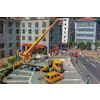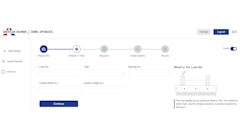
On more than one million square meters asphalt had to be paved for the new EUROGATE Container Terminal Wilhelmshaven at "JadeWeserPort" in Germany. This is the equivalent of some 50km of motorway. Due to the huge loads acting on the asphalt pavement, the demands made on quality were extremely high, especially when it came to surface accuracy. The specialists opted to use a Super 2100-2 for the job, an AB 500 extending screed in TP1 version and VÖGELE Niveltronic Plus, the system for automated grade and slope control with rotary laser receiver.
The container ships used for international shipping are growing ever larger. The latest generation of transporters have a capacity of more than 14,000 TEU (20-foot Equivalent Unit = standard container with a length of 20 feet) and deepwater harbours must now be constructed to accommodate them. The only such harbour in Germany is currently under construction at the "JadeWeserPort" – the EUROGATE Container Terminal Wilhelmshaven. Ships with a length up to 430m and a draught up to 16.5m can land and unload their cargo here. The 1,725m quayside boasts up to 16 container gantry cranes. Up to four large container ships and feeder ships can be handled simultaneously at one terminal. After unloading, the containers continue their journey on straddle carriers, with a total weight up to 100 tons often being transported on eight tires.
Completely even surface with laser receiver
To withstand the immense loads, the transport roads for the straddle carriers have to meet highly exacting demands in terms of evenness. This task was solved with a dense bond of layers comprising the base course, binder course and wearing course of asphaltic concrete. Meanwhile, the container stowage areas were designed so that they could bear huge loads without the risk of deformation for the wearing course. The paving team achieved this with an extremely coarse-grained surfacing placed directly onto the base course.
An absolutely even roadbase was crucial for the high pavement quality. Perfect evenness was achieved thanks to VÖGELE Niveltronic Plus, the system for automated grade and slope control installed in the Super 2100-2, combined with the VÖGELE laser receiver. With its wide range of up to 200m, it is an invaluable tool when paving asphalt on large areas requiring a continuously even surface. In permanent contact with the receiver, the rotary laser immediately detected deviations in elevation and automatically emitted signals for correction to the system for grade and slope control. The deviations were immediately corrected and the specified surface accuracy with a maximum admissible deviation of ± 3mm easily complied with. "We are particularly proud of the roadbase, because paving a smooth, homogeneous and close-textured wearing course on top of it was child's play," said Project Engineer Kolja Schwandt.
To maintain a perfect surface accuracy over the entire one million square metres, the Arge CT Wilhelmshaven consortium (comprising the five construction companies L. Freytag, Beton und Monierbau, Georg Koch, Hermann Janssen and Knoll), contracted to handle the project, opted for a VÖGELE Super 2100-2. "This paver is extremely reliable and achieves the required surface homogeneity," explained Volker Schäfer, head of the team of consultants. "The paver was the workhorse on this job site." The machine is perfectly designed to tackle large projects like this. All material handling systems installed in the paver are dimensioned to convey and spread large quantities of mix with ease. The conveyors and augers are equipped with particularly powerful separate hydraulic drives.
Durable longitudinal joints ensure high pavement quality
The huge area to be paved at the EUROGATE Container Terminal Wilhelmshaven was almost square. It had to be divided into a number of small individual strips with various high and low points to ensure controlled rainwater drainage. The rotary laser was regularly positioned at the high point of the "new" longitudinal axis and the longitudinal (Y) and transverse (X) pavement profiles were adjusted according to specifications.
In this way, the paver built one strip after the other. At first glance, this was an uncomplicated job, but "the demands made on the durability of the longitudinal joints were far beyond those required in normal road construction," explained Volker Schäfer. For this reason, the joints were already sprayed with polymer-modified bitumen when paving the base course. The joints of the wearing course also underwent special treatment. The results are impressive: "This is a lighthouse project, a reference project that sets new standards in terms of quality, especially with regard to evenness."
Constant team support
The first construction phase at the terminal was completed in September 2012, and the second and last sections are planned to be taken into operation in 2013. The paving teams were constantly assisted by engineers who focus exclusively on providing professional project support. This was really worthwhile: "The results from the checks related to paving material and paving performance were impeccable," says Kolja Schwandt from EUROGATE. And this was achieved despite a challenge that can thwart even the very best technology – the typical, rainy North German weather.













![Fcp Racatac Chair 10893876[1]](https://img.forconstructionpros.com/mindful/acbm/workspaces/default/uploads/2025/10/fcp-racatac-chair-108938761.10l0At5WXv.png?ar=16%3A9&auto=format%2Ccompress&bg=fff&fill-color=fff&fit=fill&h=135&q=70&w=240)
